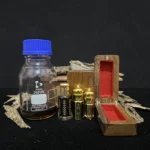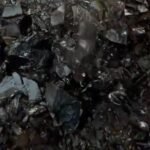
Pure Oud Resin Grading: GC-MS, Density & Masantara Oud Indonesia Standards 🔬🪵
Agarwood, the treasured commodity dubbed ‘liquid gold’ from the archipelago, now faces increasingly stringent quality demands in the global market. For premium B2B buyers, particularly in the luxury perfume sector, qualitative descriptions are no longer sufficient. They demand measurable data to guarantee the consistency of their investment in this high-value commodity.
This article serves as a technical, detailing how scientific metrics—through GC-MS Analysis and Density measurement—have become the established global industry standard in revolutionizing the agarwood resin grading process. We will guide you through understanding the crucial chemical components, and demonstrate how leading suppliers implement these layered quality standards to ensure their Premium Oud Resin products meet the highest international expectations.
I. Core Technical Specifications: The Scientific Foundation for Premium Agarwood Grading
Agarwood, or Oud Wood, is the most expensive Non-Timber Forest Product (NTFP). Its enormous value is driven by demand from the Luxury Perfumery Industry. To overcome the subjectivity of traditional grading, the industry is shifting towards the adoption of objective Pure Agarwood Resin Technical Specifications. This section outlines the industry-recognized scientific pillars used to establish Technical Authority with Premium B2B Buyers.
A. Chemical Composition Analysis: The Crucial Role of Key Compounds (GC-MS Industry Standard)
The quality and financial value of Premium Oud Resin depend entirely on the accumulated oleoresin content. Chemical analysis, particularly using GC-MS, has become the industry standard for guaranteeing authenticity and purity.
1. Identification of Primary Compounds: Sesquiterpenoids and Agarwood Chromones
The complexity of Agarwood’s aroma stems from two main classes of compounds that must be accurately and consistently quantified in the CoA:
- Sesquiterpenoid Compounds: These are the heart of the Oud aroma, imparting deep, woody-sweet, balsamic, and smoky notes. Key examples sought are, Agarofuran, Agarospirol, and Jinkohol. Research confirms that high concentrations of this group directly correlate with the highest Gubal Agarwood Quality (per SNI).
- Agarwood Chromones (2-(2-phenylethyl)chromone Derivatives): These compounds provide aromatic stability (fixative quality), sweetness, and longevity. A strong Chromone profile ensures the lasting power of the final product—a feature highly valued in the Luxury Perfumery Industry.
2. GC-MS Analysis: Establishing the Standardized Chemical Fingerprint
Gas Chromatography–Mass Spectrometry (GC-MS) is the universally used mandatory gold standard analytical method that provides the resin’s Chemical Fingerprint.
- Critical Quantitative Parameter: The primary industry focus is Total Resin Content (%), the percentage of total extractable volatile and semi-volatile compounds. Standard industry consensus dictates that Super Grade Resin must have a content of 50%.
- Qualitative Parameters: GC-MS is also the main tool for ensuring the absence of contaminants, residual solvents, or foreign chemicals. The ideal profile must show the Dominance of Sesquiterpenoids and a Strong Chromone Profile.
3. Chemical and Geographical Profile Variants (Chemotyping)
Premium prices are also determined by the chemotype, the chemical profile variation based on the Aquilaria species and geographical region. GC-MS is used to identify unique marker compounds for each species. Understanding this chemotype allows for precise pricing and fulfillment of specific demands from Premium B2B Buyers. Reputable suppliers must include a verified chemotype claim in the Certificate of Analysis (CoA).
4. Sesquiterpenoid-Chromone Ratio Metrics and Purity Index
In the advanced B2B market, more detailed metrics like specific ratios (e.g., Agarofuran to Jinkohol ratio) are often requested. These ratios offer clues about the resin’s maturity. Strict internal standards should include a Purity Index, the ratio of total target compounds (Sesquiterpenoids and Chromones) to unwanted non-volatile compounds. A high index guarantees the purity of the raw material.
5. The Influence of Solvents and Extraction Methods on Final Quality
GC-MS methods must be transparent about the solvents and extraction techniques used, as the chemical profile of Pure Agarwood Resin is highly sensitive. Polar solvents tend to extract more Chromones, while non-polar solvents excel at pulling out Sesquiterpenoids. Clear methodology reporting is an industry best practice for winning B2B client trust.
B. Agarwood Resin Density: The Physical Parameter of Excellence
Density or Specific Gravity is an easily measurable physical parameter that serves as a rapid indicator of high resin content and material purity (low moisture/void content).
1. Correlation between Density and Resin Content (Common Standard)
Density is directly proportional to the solid resin content.
- Super Premium Density: The highest grade resin (Super Gubal) has a Specific Gravity of > 1.0 g/cm (it will sink in water). This indicates highly concentrated resin content
- Mid-Grade Density: Ranges between 0.8 – 1.0 g/cm.
2. Business Implications of Density and Accuracy Standards
Verified density is crucial for Premium B2B Buyers to ensure efficiency in volume-per-weight calculations. Measurement accuracy must be stringent, performed under standardized temperature and humidity. Strict tolerances (e.g., 0.02 g/cm) are an industry best practice that must be applied to the CoA.
3. Logistical Stability and Financial Impact
Denser resin signifies lower internal moisture/voids, which directly reduces shipping costs per unit of active resin. Suppliers who guarantee verified density help optimize the investment for international B2B clients.
II. Comprehensive Grading Protocol and Industry Quality Control (QC) Implementation
An effective grading system integrates the scientific metrics discussed above with national standards (such as Standar SNI Gaharu) and global best practices.
A. Integrated Grading Matrix (Adopting Scientific Standards)
This matrix combines physical and chemical criteria for objective grading.
1. Super Grade Levels (Ultra-Premium)
| Grade | Physical Criteria (Density) | Chemical Criteria (GC-MS) | Primary B2B Application |
| Super A+++ | Specific Gravity > 1.05 | Resin Content age 60%, Absolute Agarofuran Dominance. | Haute Couture Perfume, Rare Oud Oil (Investment). |
| Super A++ | Specific Gravity approx 1.0 | Resin Content 50% – 59%, Rich Sesquiterpenoid Profile. | Primary Raw Material for Premium Oud Resin Extraction. |
2. Commercial Grade Levels (High-Volume)
- Super A+ (Gubal): Density 0.9 – 1.0 g/cm. Resin Content 40% – 49%. Ideal for consistent volume in the Luxury Perfumery Industry.
- Tanggung (Sabah): Density 0.8 – 0.9 g/cm. Resin Content 25% – 39%. Suitable for standard essential oils or incense.
B. Quality Control Implementing Global Standards: The Masantara Oud Example
The implementation of a rigorous Quality Control (QC) protocol is an agarwood industry best practice to ensure every gram of product meets the highest premium standards. These procedures significantly exceed the minimum requirements of the Standar SNI Gaharu. Masantara Oud is a leading provider that adopts this layered QC protocol, using it as their benchmark for quality assurance.
1. Sampling, Pre-Analysis Procedures, and Sample Integrity
QC begins at the raw material stage. Masantara Oud ensures these procedures are standardized:
- Initial Visual and Olfactory Testing: Led by an experienced Master Grader for quick elimination of substandard material.
- Homogeneity Sampling: Samples are taken from multiple points in the batch (not just the surface).
- Sample Integrity Protection: Samples are tested immediately and protected from volatile compound degradation, ensuring GC-MS results are accurate.
2. Internal and External Laboratory Verification
Every sample undergoes stringent testing:
- GC-MS Verification: Conducted to validate Total Resin Content and the Sesquiterpenoid Compound profile.
- Density Testing: Measurement is repeated three times to ensure data accuracy.
- Moisture Content Testing: Masantara Oud maintains moisture content below a critical threshold (maximum 5% by weight) using a standardized oven method to guarantee product stability.
3. Non-Compliance Disposition Protocol and Market Risk Mitigation
A strict disposition protocol for batches that fail to meet quality thresholds is a hallmark of responsible suppliers. Rejected batches are immediately channeled to different markets or disqualified from the Premium Oud Resin category. This Masantara Oud QC protocol proactively shields B2B buyers from the risk of receiving off-spec material.
C. Conclusion: Scientific Guarantee, Business Advantage
Adopting GC-MS Analysis and Agarwood Resin Density measurement as standards is key to transforming the Agarwood trade. By implementing stringent Quality Control, Masantara Oud Indonesia delivers the promise of consistency and integrity demanded by Premium B2B Buyers, ensuring every transaction is based on measured, industry-recognized data and high ethical standards.


